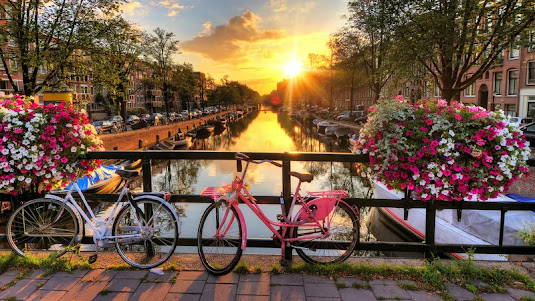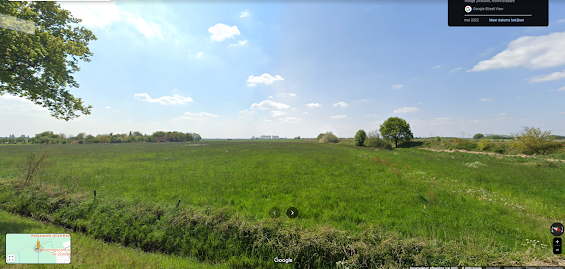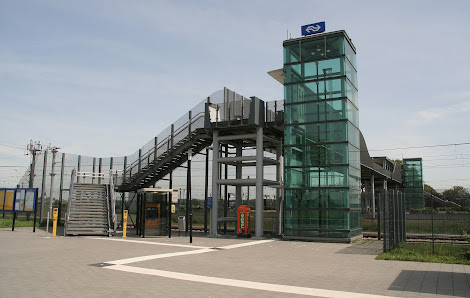Bad Dutch Public transit: Lage Zwaluwe Station
Note: This article started live as a video script. Most of the content has been regained but alterations have been made to adept to the blog format.
This… is Lage Zwaluwe train station. It is a train station located between the three Dutch cities of Dordrecht, Roosendaal and Breda and has regional train connections to all three of those places. It is also one of the most poorly designed and serviced train stations in this part of the Netherlands.
Now I can already hear you ask: “But Pim how is that possible? Those charismatic North American urbanist Youtubers told me that the Netherlands is urbanist heaven! Surely you must be exaggerating!”. Now hold your horses there because we are getting ahead of ourselves. I will talk about the portrayal of the Netherlands on urbanist Youtube later. For now let’s take a look at Lage Zwaluwe station and see what connections it has and how it’s location makes it impractical and difficult to use.
 |
| Oh my look at how quaint this city looks, clearly all of the Netherlands is like this. /sarcasm |
Lage Zwaluwe station is a train station that is situated on the State line 1 between the major cities of Breda and Dordrecht. A little to the south of the station is there also a fork in the line with a branch line that goes off to the city of Roosendaal.
The station is serviced by several so called “Sprinter” services. These are Dutch Railways regional trains that stop at every small station on the line they service. There is the Sprinter from Dordrecht to Arnhem that stops at the major cities of Breda, Tilburg, Den Bosch and Nijmegen. And there is the Sprinter from Dordrecht to Roosendaal which stops at smaller stations like Zevenbergen and Oudenbosch. Now these are for all intents and purposes pretty good train connections. According to their agreement with the government is the Dutch railways legally obligated to make every train run once every 30 minutes so you would think that this station would be used a lot. However on this line is Lage Zwaluwe one of the least used train stations with only 764 users a day on average. This is not a lot if you compare it with stations of a similar size with a similar service. Like nearby Zevenbergen with 959 users a day, Boxtel which is similar in construction to Lage Zwaluwe with 6149 users a day and even smaller Oss West with 1478 a day(1). These are all stations similar in size to Lage Zwaluwe with similar service. But why are these stations used more while Lage Zwaluwe is used so little?
There are several factors that are contributing to this. One of the most obvious ones is quite simply it’s location. Lage Zwaluwe station is named after the village of Lage Zwaluwe but the station is not actually in this village. Rather it is situated about 5 to 6 km to the west of the village. It is actually closer to the settlements of Moerdijk and Zevenbergschen-Hoek. This already makes it somewhat impractical to use for the people in the settlements around the station considering it is quite out of the way.
Another issue is the fact that the station is close to a highway. This is the A16 highway that runs from Antwerpen in Belgium all the way to Rotterdam. This highway is packed and during rush hour you will often get stuck in traffic. This makes being on this station quite noisy and not exactly ideal or comfortable. The fact that this station has a decently sized parking lot only reinforces the fact that it was aimed at car users.
Another issue is the fact that the station has poor public transit connections to the aforementioned settlements around it. Lage Zwaluwe station is serviced by 3 buses. Bus 122, Bus 218 and bus 618. I am not gonna talk much about Bus 618 since it is a school bus that only goes once in the morning and twice in the afternoon during rush hour. Bus 218 however is a so called “buurtbus” that goes from Zevenbergen to Langeweg. Which means that it is a very small van shaped bus that you are sitting in cramped while it very slowly chugs along the countryside. This bus goes once per hour during the weekday and does not go in the evening or during the weekend. This is not a good schedule that works well for the people living in Langeweg, Moerdijk or Zevenberschen-Hoek.
However the main bus I want to talk about is bus 122. This is a bus that starts at Lage Zwaluwe station and moves from Lage Zwaluwe through Hooge Zwaluwe, Helkant, Wagenberg and Terheijden to Breda. Like bus 218 drives this bus once every hour on weekdays, doesn’t it drive in the evening and doesn’t it drive during the weekends. The difference is that unlike bus 218 is bus 122 a fully sized bus. Another difference is that it drives through places that are quite far away from train stations. Hooge Zwaluwe is serviced only by bus 122 and the bus only stops at Wagenberg and Terheijden at 2 bus stops on the edge of the village. This means that if you live in any of these places you are reliant on an infrequent bus service that doesn’t go in the evening or the weekend, that you need to go out of your way to get to the bus stop on the edge of town to even make use of it. I don’t think I need to explain why this is not ideal.
 |
| This is the schedule of Bus 122, Note the lack of a weekend schedule |
 |
| The Route Bus 122 takes |
I think that at this point it is only fair if I lift a tip of the shroud and reveal the fact that I had a somewhat ulterior motive when I picked Lage Zwaluwe train station as my subject for this video. You see I used to live in this area. I lived in Helkant from 2002 till 2010. I lived in Hooge Zwaluwe for like 7 months from late 2010 till early 2011 and I lived in Made from 2011 till 2016. As such am I very familiar with the public transit in this area and I can speak from personal experience that it is not great. I have spent hours waiting at bus stops for an infrequent bus that might not even show up. At one point I had 2 hourly buses that did not show up and I ended up canceling the thing I wanted to go to just because at that point I was delayed so badly that I would be spending more time traveling then actually spending time at the meeting. This is unfortunately a common experience if you live or need to travel to a rural area in the Netherlands.
Now I can already hear you ask: “But Pim can’t you bike to places easily there?” and the answer is yes to an extent. When I lived in this area I indeed biked to a lot of places. However biking is not always a good solution. Biking is fun and can be easy to do at a nice day. But needing to do it on a daily basis regardless of the weather conditions is just not really a good replacement for public transit. Especially not at longer distances that we are talking about here. Helkant to Breda is 50 minutes to an hour by bike. Helkant to Lage Zwaluwe station is also like 40 minutes. And you have to do this through all weather conditions. Rain, Thunder, Snow. Have fun cycling through an extremely flat area during a thunderstorm. Hope you don’t get hit by lightning.
If you live in a place like Hooge Zwaluwe and you need to take the train during the evening or weekend then your best option is to either walk or bike to the bus stop at the roundabout of Wagenberg and hope that one of the other buses shows up. Or bike directly to the train station in Lage Zwaluwe. Neither are ideal options. Especially if you are older or have some kind of disability that makes movement difficult for you. This especially is why I always hate it whenever someone tells us to just “go bike” because it is not always an option. Don’t get me wrong. I like biking and I love Dutch biking infrastructure. However it is very much a supplement to transit, not a replacement.
 |
| At least the scenery is pretty |
Do you know what really hurts me about this? It was not always like this. Back in the early 2010’s when I went to college I recall Bus 122 going once every 30 minutes during weekdays and once per hour during the weekend. I also remember there being more bus stops in Wagenberg and Terheijden that were actually touched upon by bus 122(3). Sure this is still not amazing but it was one hell of an improvement over what we have now. If you go back even longer then you might even find that places like Hooge Zwaluwe, Drimmelen and Made used to be accessible by train since you used to have a rail line going from Lage Zwaluwe to Den Bosch via Waalwijk. Plus a lot of these places used to have steam tram connections to bigger cities. So what happened here? Why is it so bad now? Well the Steam trams got replaced in the 50’s when buses became prominent and the train stations in Hooge Zwaluwe and Made got closed around that time as well. However for the more recent developments I think it is best if we look at how regional public transit works in the Netherlands.
 |
| Our region would fall under the concession West-Brabant |
Before the year 2000 were most buses in the Netherlands run by a series of municipally owned companies. Some of these companies were consolidated and run as consortium's but they were still publicly owned. Then came the year 2000 and with that came privatization(4). A few years earlier the government had already broken up the Dutch Railways monopoly on the rail network, forcing them to give up lines in the North and East to private operators and this privatization effort of bus lines was their next step in that. So as a result a lot of these consortium’s became private for profit companies. And a few years later were most of them bankrupt. This resulted in the creation of the concession system as it exists now. Basically what they did is cut the country into a series of regions for public transit and then award those regions to a private operator for a determined time period(usually like 15 years).
The provinces in which those regions lie do have a say in what line goes where and how frequently it goes but overall is it all up to the private operators to run as they see fit. Which is where the problem lies. You see there are countless examples of recent history where public transit got privatized and it caused a decline in quality and frequency. When you privatize public transit you create a profit motive for the private company running the thing. This means that profit becomes the main goal of the company rather then a good service, meaning that lines and bus stops that are unprofitable are gonna get cut or have their frequency removed. We saw this in the UK with privatization efforts there that destroyed communities, we saw it in the US with the collapse of Penn Central and the forced nationalization under Conrail and Amtrak, we saw it in Germany when the Deutsche Bahn was forced to give up a lot of their lines. History has proven time and time again that you cannot run a public service with a profit motive and still keep up the quality that is expected of a public service. I call this the Neoliberal public transit doom spiral because you get a runaway effect.
Let’s have an example. Private transit company A has Line J which is unprofitable. So they cut the frequency with which it runs in half. Which means it becomes less attractive for people to use it. Which means that it is unprofitable, which means it gets cut in half again etc etc etc. In the end you have nothing left. It is really easy to remove lines and bus stops, it is a lot harder to build them up again. This is why from the time period of 2018 to late 2022 the Netherlands lost over 1500 bus stops(2). Most of them in rural areas like this. Keeping everything I have just said in mind, is it any wonder that Lage Zwaluwe station is used so infrequently? Why would you use a train station that is difficult to reach by public transit and too far to easily bike or walk to? If you are living in a place like Hooge Zwaluwe or Moerdijk, wouldn’t it just be easier to get a car? This is the issue that you see in a lot of rural places in the Netherlands right now.
And this isn’t just restricted to rural villages. You see it in bigger cities as well. Many cities outside of the Randstad are losing bus lines left and right for the same reasons that I mentioned before and this causes problems for the people living here. These are not small backwaters btw, these are pretty big cities with over half a million people living in it. Places like Eindhoven, Tilburg, Breda, Nijmegen, Apeldoorn, Enschede, Groningen and Leeuwarden. All of this culminates in a lot of friction between the people of the Randstad and the people outside of it. There exists this idea over here that we do not matter to the politicians in Den Haag. That we are abandoned and left to fend on our own. All of this feeds into a nasty far right reactionary current which seeks to destroy marginalized groups which they blame incorrectly for these issues.
That is not to say that it is the end of the world in the Netherlands. There are plenty of places in North America that would kill for an hourly bus during weekdays. However it does highlight an issue I have about how the Netherlands is discussed on Youtube. People praise the Netherlands for our bike infrastructure and amazing trains and don’t get me wrong, those are good things to have and it is good to highlight how to do things right. But these discussions rarely if ever talk about the negatives of public transit and infrastructure over here, there is no talk about how public transit is spiraling. How there are constant staff shortages and how private operators are running bus lines on a shoe string budget. I think it is important that if you are gonna show the good sides of the Netherlands that it is equally important that you talk about the bad sides of infrastructure in the Netherlands and especially the political forces that caused it to be bad. When I see an American or Canadian Youtuber talk about the Netherlands I am just baffled because their experience of living in Amsterdam is legit alien to me. I remember having a culture shock years ago when I went to Den Haag for a convention and I was baffled at how the trams were still running every 15 minutes in the middle of the night on a Sunday. This shows to me that we can do better in other places as well.
So please let us strife to improve the public transit outside of the big cities as well. Bring back the weekend and evening buses, bring back the 30 minute bus frequency on weekdays. Make it more attractive to actually go outside of those big cities. Bring back publicly owned public transit companies and let us reverse this doom spiral that we are all in. We can only do it together after all.
Sources/References:
1. https://dashboards.nsjaarverslag.nl/reizigersgedrag
2. https://nos.nl/collectie/13923/artikel/2465241-ruim-1500-bushaltes-minder-dan-in-2018-impact-verschilt-lokaal-sterk
3. https://wiki.ovinnederland.nl/wiki/Dienstregeling_concessie_West-Brabant_2016
4. https://nl.wikipedia.org/wiki/Wet_personenvervoer_2000









Comments
Post a Comment